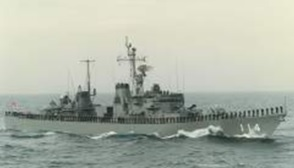JDS Makigumo
 JDS Makigumo
| |
| History | |
|---|---|
| Name |
|
| Namesake | Makigumo (1941) |
| Ordered | 1963 |
| Builder | Uraga, Uraga |
| Laid down | 10 June 1964 |
| Launched | 26 July 1967 |
| Commissioned | 19 March 1966 |
| Decommissioned | 1 August 1995 |
| Reclassified | TV-3507 |
| Homeport | Kure |
| Identification | Pennant number: DD-114 |
| Fate | Scrapped |
| General characteristics | |
| Class and type | Yamagumo-class destroyer |
| Displacement | 2,050 long tons (2,083 t) standard |
| Length | 114.0 m (374 ft 0 in) overall |
| Beam | 11.8 m (38 ft 9 in) |
| Draft | 3.9 m (12 ft 10 in) |
| Propulsion |
|
| Speed | 27 knots (31 mph; 50 km/h) |
| Range | 6,000 nmi (11,000 km) |
| Complement | 210 |
| Sensors and processing systems | AN/SQS-23 |
| Electronic warfare & decoys | NOLR-1B |
| Armament |
|
JDS Makigumo (DD-114) was the second ship of Yamagumo-class destroyers.
Construction and career
[edit]Makigumo was laid down at Uraga Dock Company Uraga Shipyard on 10 June 1964 and launched on 26 July 1967. She was commissioned on 19 March 1966.[1]
On 1 December 1977, the 21st Escort Corps was reorganized under the 3rd Escort Corps group.[citation needed]
In 1985, participated in a practicing voyage to the ocean.[citation needed]
On 20 February 1987, the 21st Escort Corps was reorganized under the Sasebo District Force.[citation needed]
On 20 June 1991, she was reclassified as a training vessel and her registration number changed to TV-3507. She was transferred to the 1st Training Squadron and her home port was transferred to Kure. The remodeling work to a training ship was carried out from 28 June to 24 October of the same year, and the ASROC launcher was used as a trainee auditorium (accommodating 36 people), and a part of the officer's bedroom was for female SDF personnel. It was remodeled to 14 people).[citation needed]
She was removed from the register on 1 August 1995.[2][3]
Gallery
[edit]-
JDS Makigumo's plaque
-
JDS Makigumo's bell and shield
-
JDS Makigumo's wheel



